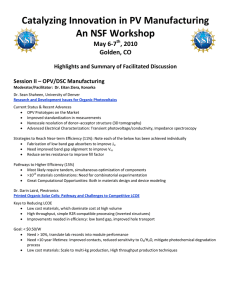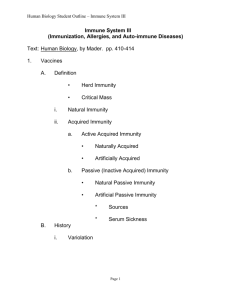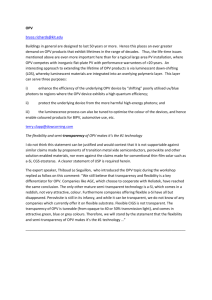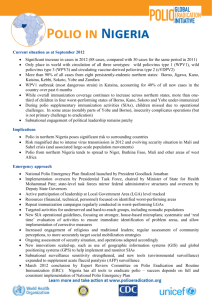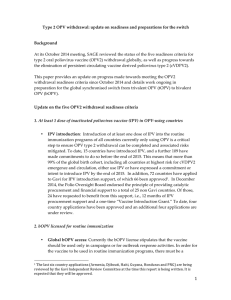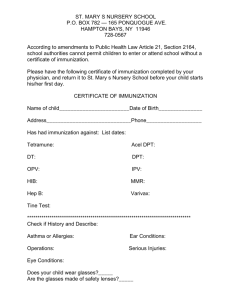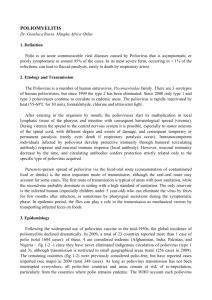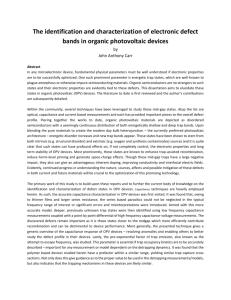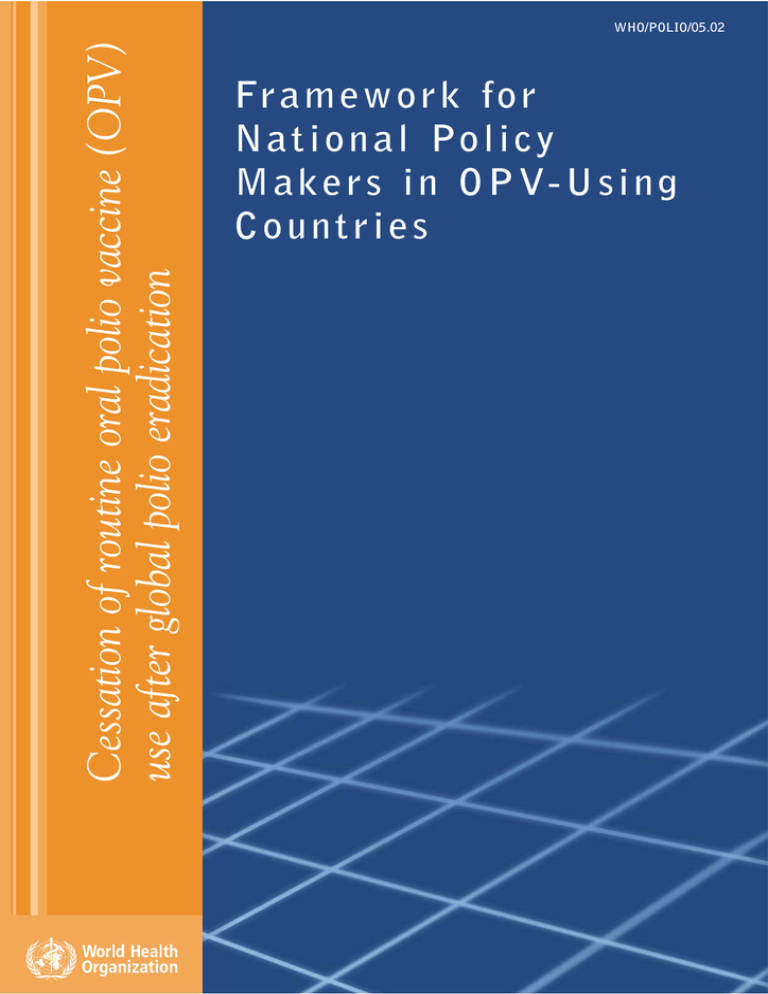
Cessation of routine oral polio vaccine (OPV)
use after global polio eradication
WHO/POLIO/05.02
Fr a m ew o r k fo r
N a t i o n a l Po l i c y
M a k e r s i n O P V- U s i n g
Countries
Index
1. Introduction
2. Rationale for eventual cessation of oral polio vaccine (OPV) use in routine immunization
after eradication
3. Risks associated with OPV cessation
4. Risk management before, during and after OPV cessation: implementing the prerequisites
for OPV cessation
I
Confirmation of interruption of wild poliovirus transmission globally
II
Appropriate biocontainment of all polioviruses
III
International stockpile of monovalent OPVs (mOPV)
IV
Highly-sensitive surveillance for circulating polioviruses
V
Procedure for internationally-simultaneous OPV cessation
VI
Long-term routine polio immunization policy
5. Timetable for OPV cessation
6. Glossary of terms
© World Health Organization 2005
All rights reserved. Publications of the World Health Organization can be obtained from WHO Press, World Health Organization,
20 Avenue Appia, 1211 Geneva 27, Switzerland (tel: +41 22 791 2476; fax: +41 22 791 4857; email: bookorders@who.int).
Requests for permission to reproduce or translate WHO publications – whether for sale or for noncommercial distribution – should
be addressed to WHO Press, at the above address (fax: +41 22 791 4806; email: permissions@who.int).
The designations employed and the presentation of the material in this publication do not imply the expression of any opinion
whatsoever on the part of the World Health Organization concerning the legal status of any country, territory, city or area or of its
authorities, or concerning the delimitation of its frontiers or boundaries. Dotted lines on maps represent approximate border lines
for which there may not yet be full agreement.
The mention of specific companies or of certain manufacturers’ products does not imply that they are endorsed or recommended
by the World Health Organization in preference to others of a similar nature that are not mentioned. Errors and omissions excepted,
the names of proprietary products are distinguished by initial capital letters.
All reasonable precautions have been taken by the World Health Organization to verify the information contained in this
publication. However, the published material is being distributed without warranty of any kind, either express or implied. The
responsibility for the interpretation and use of the material lies with the reader. In no event shall the World Health Organization
be liable for damages arising from its use.
Printed by the WHO Document Production Services, Geneva, Switzerland
1
1. Introduction
Polio eradication - global overview as at 2005
By early 2005, the annual number of polio cases reported globally had been reduced by over 99 %
since the Global Polio Eradication Initiative was launched in 1988. In addition, endemic wild
polioviruses had been eliminated from all but six countries in the world (Nigeria, India, Pakistan,
Niger, Afghanistan and Egypt), demonstrating that the polio eradication strategies can work in all
settings. Following the large polio epidemic of 2003-2004 in west and central Africa, which spread
to 16 previously polio-free countries, a massive 'intensified' effort has been launched and is
anticipated to stop polio transmission globally in the near future.
With the 'intensification' of the global polio eradication effort in 2004-2005, preparations are
being made for simultaneous oral polio vaccine (OPV) cessation soon after assurance of the
complete interruption of wild poliovirus transmission.
In 1988, World Health Assembly (WHA)
resolution 41.28 established the goal of polio
eradication as 'interruption of wild poliovirus
transmission' globally. Since 1999, however,
increasing scientific data demonstrate that polio
eradication will also require the eventual
cessation of OPV use in routine immunization
programmes. Otherwise, the continued
reintroduction of the attenuated polioviruses of
OPV into a polio-free world will result in polio
cases due to vaccine-associated paralytic polio,
and polio outbreaks due to circulating vaccinederived polioviruses1.
The international oversight bodies that guide the
Global Polio Eradication Initiative concluded in
2003 and 2004 that OPV cessation should occur
as soon as possible after the interruption of wild
poliovirus transmission globally, while population
immunity against polio and surveillance
sensitivity for acute flaccid paralysis remain high2.
Minimizing the risks associated with stopping
OPV requires careful preparation at the national
and international levels and, eventually,
simultaneous OPV cessation across all remaining
OPV-using countries to ensure that no country is
placed at risk of importing a vaccine-derived
poliovirus from an area where OPV use
continues.
This document has been developed to provide
national health policy makers in OPV-using
countries with an overview of the rationale, risks,
prerequisites and potential timetable for the global
cessation of OPV. Particular emphasis is given to
those activities required at the country level during
the ongoing 'OPV Cessation Preparatory Phase'.
"After eradication of wild poliovirus, continued use of oral polio vaccine (OPV) would
compromise the goal of a polio-free world." Advisory Committee on Poliomyelitis Eradication
(ACPE), Geneva, 21-22 September 2004
1
2
Conclusions and Recommendations of the Advisory Committee on Poliomyelitis Eradication (ACPE),
Geneva, Switzerland, 21-22 September 2004
WHO Informal Consultation on Identification and Management of Vaccine-derived
Polioviruses. September 2003, Geneva, Switzerland.
2
2. Rationale for eventual cessation of
oral polio vaccine (OPV) use in routine
immunization after eradication
OPV is the appropriate – and only recommended –
polio vaccine for achieving the eradication of wild
polioviruses worldwide3. However, OPV can also
cause – in rare instances – paralytic polio cases.
Consequently, once wild poliovirus transmission
has been interrupted globally, the attenuated
Sabin poliovirus strains used in OPV could
continue to cause polio cases and outbreaks at a
rare but predictable rate. Therefore, the
continued use of OPV after the interruption of
transmission of wild poliovirus is increasingly
considered inconsistent with eradication. Polio
cases due to vaccine-associated paralytic
poliomyelitis (VAPP) and outbreaks due to
circulating
vaccine-derived
polioviruses
(cVDPVs), are the two main reasons for
eventually stopping the use of OPV for routine
immunization in all countries.
1. Polio Cases due to Vaccine-Associated Paralytic Poliomyelitis (VAPP): the continued
use of OPV will result in a predictable burden of polio disease due to VAPP.
VAPP cases will continue to occur at a rate of 2-4 cases per one million birth cohort,
wherever OPV is used. If the OPV utilization patterns of 2005 continued after
confirmation of the eradication of wild-type poliovirus, between 250 and 500 new
VAPP cases would be expected to occur worldwide each year.
While the risk of polio due to wild poliovirus currently outweighs the risk of
VAPP in most countries, this balance will change with confirmation of the
interruption of wild poliovirus transmission globally.
2. Polio Outbreaks due to circulating Vaccine-Derived Polioviruses (cVDPV): the
continued use of OPV will result in a predictable rate of polio outbreaks due to
cVDPVs.
Since 2000, four polio outbreaks due to cVDPVs have been documented in
Hispaniola (in 2000-2001), the Philippines (in 2001), Madagascar (in 2002) and
China (in 2004), resulting in a total of 31 polio cases. A fifth outbreak was
described retrospectively in Egypt.
While low routine immunization coverage probably contributes to the conditions
that give rise to cVDPVs, and mass campaigns with OPV eventually stopped each
reported outbreak, it appears that even major improvements in routine polio
immunization coverage would be unlikely to prevent future polio outbreaks due
to such events. Unlike smallpox, the eventual cessation of OPV must be
synchronized across all countries so that the risk of cVDPV decreases rapidly and
uniformly throughout the world, thus ensuring that no country is placed at risk
of importing a cVDPV from an area where OPV use continues.
3
Hull HF, Lee JW. Sabin, Salk or sequential? The Lancet. March 1996
3
In addition to these primary reasons for eventually
stopping routine OPV immunization, continued
use of the vaccine would, rarely, lead to prolonged
excretion (> 6 months) of a VDPV from a person
with a severe primary immunodeficiency
syndrome. Theoretically, these 'iVDPVs' could
then reintroduce poliovirus into the general
population. In 40 years of OPV use, 28 iVDPVs
had been documented by end-2004, though none
had been shown to cause secondary cases. Four of
these were 'chronic' iVDPVs (excretion > 36
months), all of which occurred in high-income
countries.
Once eradication of wild poliovirus has been
confirmed, the public health benefits of routine
immunization with OPV will no longer outweigh
the burden of disease due to VAPP and cVDPVs.
Despite these shortcomings of OPV, successful
eradication depends on maintaining high
coverage with this vaccine until the point of
simultaneous OPV cessation. Decreases in OPV
immunization coverage prior to the time of OPV
cessation would put polio-free countries at risk of
wild poliovirus importations and cVDPVs.
Polio outbreaks due to circulating vaccine-derived
polioviruses (cVDPV), 2000-2004
China
2004
2 cases
Hispaniola
2000
22 cases
Madagascar
2002
4 cases
Philippines
2001
3 cases
OPV Facts
If the worldwide OPV utilization patterns of 2005 continued after confirmation of the
eradication of wild-type poliovirus, it is expected that there would be:
• 250 to 500 cases of VAPP per year,
• Up to one polio outbreak due to a cVDPV per year.
Once eradication of wild poliovirus has been confirmed, the public health benefits of routine
immunization with OPV may no longer outweigh the burden of disease due to VAPP and
cVDPVs.
4
3. Risks associated with OPV cessation
Although the burden of disease caused by VAPP
and cVDPVs will eventually outweigh the
benefits of routine OPV immunization, OPV
cessation is associated with risks that must be
managed appropriately.
For most OPV-using countries, the risks
associated with OPV cessation can be summarized
in two main categories:
1. Immediate risk of cVDPV emergence: once
countries simultaneously stop using OPV, there will
be a time-limited, rapidly decreasing risk that a
vaccine-derived poliovirus could regain
neurovirulence and begin to circulate, which would
require an outbreak response. For any individual
country, the risk of such an outbreak is remote and
diminishes rapidly over the 12-24 month period
immediately following simultaneous OPV
cessation. This risk will be lowest in countries with
high routine immunization coverage at the time of
OPV cessation. Although the risk of a cVDPV
outbreak is low for individual countries, there is an
estimated 65-90% chance of such an outbreak
occurring somewhere in the world during the first
year after simultaneous OPV cessation. This risk
will fall to 5-15% by the end of the second year if
OPV cessation can be implemented simultaneously
worldwide, and will reduce further to 1-5% by the
end of the third year.
Risk of cVDPV outbreaks*
Probability of at least one cVDPV outbreak
1.00
0.90
0.80
OPV (without SIAs)
IPV
No routine
0.70
0.60
0.50
0.40
0.30
0.20
0.10
0.00
0
1
2
3
4
5
6
7
8
Time (years) after T0
* Based on Duintjer-Tebbens RJ et al. Risks of Paralytic Disease due to Wild or
Vaccine-derived Poliovirus after Eradication (Submitted). Probabilities assume
realistic population immunity at T0, include low, lower-middle and upper-middle
income countries (currently using OPV).
9
Two main risk-categories associated with
OPV cessation:
1. Immediate risk of cVDPV emergence
2. Medium and long-term risks of poliovirus
re-introduction
from
a
vaccine
manufacturing site, research facility or
diagnostic laboratory
2. Medium and long-term risks of poliovirus
re-introduction: once it has been verified that
OPV is no longer being used in routine
immunization anywhere, the greatest risks to a
polio-free world will be the inadvertent reintroduction of a wild, vaccine-derived or Sabin
strain of poliovirus from a polio vaccine
manufacturing site, a research facility or a
diagnostic laboratory. This risk is low, as
documented poliovirus re-introductions were
rare even prior to the adoption of international
guidelines for the containment of polioviruses by
the World Health Assembly in 1999. This risk
will diminish further as all countries fully
implement appropriate biocontainment of
polioviruses and verify that achievement.
Achieving appropriate containment of all
polioviruses will be extremely important given
that the potential harmful consequences of a
poliovirus re-introduction will increase
substantially as polio-susceptible individuals
accumulate after OPV cessation. The risk of
reintroduction of a vaccine-derived poliovirus
from an iVDPV is still lower, for the reasons
noted in section 2 above.
Although the risks associated with stopping OPV
use in routine immunization are relatively small,
these risks can be further reduced through
international implementation of appropriate risk
management strategies before, during and after
OPV cessation. Implementation of these risk
management strategies – or prerequisites – will
involve close oversight by National Policy
Makers.
5
4. Risk management before, during
and after OPV cessation: implementing
the prerequisites for OPV cessation
Six prerequisites for simultaneous OPV
cessation:
I Confirmation of interruption of wild
poliovirus transmission globally
II Appropriate biocontainment of all
polioviruses
III International stockpile of monovalent
OPV (mOPV)
IV Highly-sensitive surveillance for
circulating polioviruses
V Procedure for internationallysimultaneous OPV cessation
VI Long-term routine polio immunization
policy (i.e. national IPV decisions)
The strategies needed to minimize and manage
the risks associated with eventual OPV cessation
are considered 'prerequisites' for stopping routine
immunization with this vaccine. The six
prerequisites that have been established for OPV
cessation are:
I
C ONFIRMATION
OF INTERRUPTION OF
WILD POLIOVIRUS TRANSMISSION
GLOBALLY
wild poliovirus transmission in the last six polioendemic countries and the six countries where
poliovirus transmission was re-established
following importations in 2003-2004. All
countries in regions yet to be certified as polio-free
must demonstrate zero polio cases for a minimum
of three years, in the presence of 'certification
standard' surveillance, prior to OPV cessation.
II
A PPROPRIATE
BIOCONTAINMENT OF
ALL POLIOVIRUSES
Issue: all wild, vaccine-derived and Sabin
polioviruses must be placed under appropriate
biocontainment levels on a timely basis to
minimize the risk of re-introduction into a poliofree world.
Status: in 2003, high level biosafety requirements
were internationally agreed for vaccine-derived
and wild-type polioviruses4. By end-2004, 152
countries had initiated a survey for wild-type and
vaccine-derived poliovirus infectious and
potentially infectious materials, covering over
200,000 facilities. Approximately 850 facilities
were identified with relevant infectious materials.
These materials will either be destroyed or placed
under appropriate biocontainment conditions.
Next Steps: by the time wild poliovirus
Issue: because of the ongoing risk of poliovirus
importations into polio-free areas, the
interruption of wild poliovirus transmission
Wild poliovirus containment:
must be confirmed in every country in the progress with Phase I - Survey & Inventory, 2004
world prior to the cessation of routine polio
immunization anywhere.
Status: in 1995 the Global Commission for
the Certification of Poliomyelitis Eradication
(GCC) established the criteria for
confirming the interruption of wild
poliovirus transmission. As of end-2004,
135 countries in three WHO Regions had
been certified polio-free (WHO regions of
Polio endemic
Re-established transmission
the Americas, Europe and Western Pacific).
Survey not yet started
Conducting survey
Next Steps: intensified efforts are being
Reporting completion of survey and inventory of laboratories with wild poliovirus materials
made to interrupt the remaining chains of
4
WHO Global Action Plan for Laboratory Containment of Wild Polioviruses (GAP II), Second edition.
World Health Organization, Geneva, Switzerland, 2003. (WHO/V&B/03.11)
6
transmission is interrupted globally, all countries
must have completed a national survey and
inventory of facilities holding wild or vaccinederived polioviruses. The process of destroying or
properly containing those materials must be
completed twelve months later. At an
international level, consensus must be established
on appropriate future biosafety containment
levels for Sabin viruses, the timing of the
implementation of such activities and the
mechanisms for verification. The development
and licensure of IPV-produced from Sabin strains
(SIPV) will continue to be pursued to further
reduce the number of sites generating high
volumes of high titre wild polioviruses for IPV
production.
internationally-agreed in a World Health
Assembly resolution. The potential role of IPV,
and possibly antivirals, in outbreak response must
also be fully elaborated.
IV H IGHLY- SENSITIVE
SURVEILLANCE FOR
CIRCULATING POLIOVIRUSES
Issue: highly sensitive surveillance is required
before, during and after OPV cessation to
confirm interruption of wild poliovirus
transmission, document the elimination of Sabin
strains, and rapidly detect the potential reintroduction of any poliovirus.
Status: in 2004, 66 polio-endemic or recentlyendemic countries met or exceeded the
surveillance performance standards established by
the GCC, including most countries that are
affected or recovering from conflict such as
Afghanistan, Angola, the Democratic Republic of
the Congo and Somalia. However, declining rates
of acute flaccid paralysis (AFP) surveillance in a
number of countries that have been certified
polio-free, and the recent detection in Africa of
polioviruses that were missed due to suboptimal
AFP surveillance, re-affirms the need to
strengthen surveillance and maintain the full
certification surveillance criteria everywhere.
Next Steps: all countries must strengthen AFP
surveillance to ensure it can be sustained at
certification standard throughout the three-year
plus period of OPV cessation and verification of
the elimination of Sabin- and vaccine-derived
polioviruses. In addition, high- and middle-
STOCKPILE
OF
III I NTERNATIONAL
MONOVALENT OPV ( M OPV)
Issue: an international stockpile of types 1, 2 and
3 monovalent OPV is needed particularly to
allow a 'type-specific' response during the process
of OPV cessation (thereby enhancing the impact
of the outbreak response while preventing the reintroduction of other polioviruses).
Status: in 2004, all producers of WHOprequalified OPV and their respective national
regulatory agencies were invited to collaborate
with WHO on the development, licensure and
production of monovalent type 1, type 2 and type
3 OPV. Working estimates have been established
for the number of doses required of each mOPV
type, development timelines have been elaborated,
and the Global Alliance for Vaccines
Surveillance for non-polio acute
and Immunization (GAVI) will
flaccid paralysis (AFP) - 2004
review a stockpile investment case for
funding. As the result of an
accelerated vaccine development
project, two mOPV type 1 vaccines
were licensed in early 2005 and are
undergoing
large-scale
field
evaluation.
Next Steps: the development,
production and procurement of
mOPV for the stockpile is scheduled
< 0.5
0.5 -1
≥1
No AFP Surveillance
to begin in 2006. The mechanisms
Per 100,000 population aged <15 years
Data in WHO HQ as of 25 April 2005
and criteria for the future use of the
stockpile must be completed and
7
income countries should screen for iVDPVs
among
individuals
with
primary
immunodeficiency
syndromes.
At
the
international level, event-based reporting for
‘suspect polio’ will need to be fully incorporated
into the new International Health Regulations. New
diagnostic tools for the OPV cessation phase,
particularly IgM assays and direct molecular
detection techniques, must be fully evaluated and
integrated into the polio laboratory network.
V
PROCEDURE
FOR INTERNATIONALLY-
SIMULTANEOUS OPV CESSATION
Issue: all countries will need to simultaneously
stop the use of OPV for routine immunization to
ensure that no country is inadvertently put at risk
of importing a cVDPV from a country that
continues to use OPV.
Status: the international bodies providing
oversight to the Global Polio Eradication Initiative
have endorsed the need for eventual simultaneous
OPV cessation. WHO has begun the process of
developing and pilot testing guidelines for the
withdrawal of OPV from routine immunization
programmes. These guidelines will emphasize the
need to maintain the highest possible level of
OPV coverage until the actual time of
simultaneous OPV cessation.
Next Steps: all remaining polio-infected countries
must interrupt wild poliovirus transmission as
rapidly as possible to allow the development of a
firm timeline for OPV cessation. A World Health
Assembly Resolution outlining the precise timing
and process for simultaneous OPV cessation by all
OPV-using countries could be required as early as
2006. At the national level, detailed plans for the
withdrawal and destruction of all trivalent OPV
stocks, from all levels of the country, will need to
be developed and national immunization policies
revised accordingly. Following OPV cessation,
documentation of the destruction of remaining
trivalent OPV stocks will need to be verified in
each country.
VI L ONG - TERM
polio after OPV cessation (after OPV cessation,
IPV will be the only option for those countries
which decide to continue routine immunization).
Status: based on an evaluation of the costs and
benefits of continued polio immunization after
OPV cessation, and the needs of other disease
priorities, WHO is recommending that OPVusing countries do not routinely introduce IPV at
that time. WHO is, however, assisting those
polio-free countries that have requested support to
evaluate the potential role of IPV in their national
immunization programme. To facilitate national
decision-making on IPV, WHO published an
IPV Position Paper in 2004 summarizing the
characteristics, efficacy and potential role of the
vaccine. A separate WHO study detailed the
major programmatic implications of IPV
introduction, many of which are not immediately
apparent, for most OPV-using countries (e.g. the
need to increase cold chain capacity, change the
pertussis component of combination vaccines, use
vaccines with a different preservative)5. Initial
results from modelling studies commissioned by
the Global Polio Eradication Initiative suggest
that for most low-income countries, the
introduction of IPV for routine immunization
would only marginally reduce the already small
risks associated with OPV cessation.
Next Steps: any OPV-using country which is
considering the potential introduction of IPV
should systematically evaluate the risks and benefits
of continuing polio immunization following OPV
cessation, including the impact this could have on
other priority disease control programmes. WHO
will continue to review the potential role of IPV as
additional data are collected on the risks associated
with OPV cessation.
ROUTINE POLIO
IMMUNIZATION POLICY
Issue: each OPV-using country must decide
whether to stop all routine immunization against
5
WHO presentation at 3rd WHO/UNICEF Informal Consultation with IPV and OPV Manufacturers. June 2004,
Geneva, Switzerland.
8
5. Timetable for OPV cessation
The timetable for OPV cessation can be divided the absence of cVDPVs. The major risk during
into three distinct periods correlating with the this period will be the emergence of a cVDPV
evolution of the major polio risks and risk (which would trigger a type-specific outbreak
management strategies. The precise timing of response with the appropriate mOPV).
these phases will depend on the date of Post-OPV Era: this period will begin with the
interruption of wild poliovirus transmission verification of the disappearance of Sabin-strain
globally and progress towards achieving the six polioviruses, as well as the absence of cVDPVs.
prerequisites outlined earlier.
This period will continue indefinitely. The
Regional Certification & OPV Cessation major risks during this period (in decreasing
Preparatory Phase: this phase has already order of potentially-damaging consequences)
begun and will continue for three years after the would be the re-introduction of a wild, vaccinelast case of polio caused by wild-type poliovirus derived or Sabin-strain poliovirus.
is detected anywhere in the world. The major
risk during this period will be
Potential timeline and priority activities for eventual cessation of
undetected
wild
poliovirus
oral polio vaccine (OPV) for routine immunization
transmission due to suboptimal AFP
Phase of OPV cessation work
surveillance. The national polio
Interruption
Certification &
'Post OPV'
OPV Cessation &
eradication priorities during this phase
of wild
Preparation for OPV
Era
Verification
poliovirus
Cessation
are outlined in Box 1.
Certify interruption of
Simultaneously stop
Maintain
OPV Cessation & Verification
wild virus transmission all routine use of OPV surveillance
Phase: this phase will begin with the
Contain wild &
Contain Sabin strain
Maintain
vaccine-derived
polioviruses
stockpile
simultaneous cessation of OPV
polioviruses
worldwide and will continue for at
Develop mOPV stockpile Verify the absence of
Verify
& criteria for use
cVDPV & Sabin virus containment
least three years thereafter, until
Establish national policy Fully integrate poliovirus
on IPV use
surveillance into IHR
verification of the disappearance of
Sabin poliovirus strains from the
-1
0
1
2
3
4
5
6
7
8
Years after last circulating wild poliovirus
human population globally, as well as
Box 1: Priorities for National Policy Makers in OPV-Using Countries
OPV Cessation Preparatory Phase
• Strengthen polio (AFP) surveillance to guide interruption of wild poliovirus transmission,
certify eradication, and detect potential importations and cVDPVs.
• Fully implement – and verify – appropriate containment of wild and vaccine-derived
polioviruses and prepare for Sabin-virus containment.
• Raise routine immunization coverage (target >90%) to minimize the risk of spread of an
imported poliovirus and the risk of cVDPV emergence.
• Decide - based on analysis of risks, benefits and opportunity costs - whether to stop all routine
immunization against polio after OPV cessation (when inactivated polio vaccine will be the
only option for continued routine immunization).
• Conduct an iVDPV ‘risk assessment’ and establish a case management plan, if needed.
• Establish national plans and mechanisms for the eventual cessation of all OPV use in routine
immunization programmes and destruction of remaining trivalent OPV stocks (note:
standard template will be available 12-24 months beforhand).
Further information and technical support is available from WHO country and regional offices, as
well as from the Global Polio Eradication Initiative, WHO Geneva.
9
6. Glossary of terms
ACPE
Advisory Committee on Poliomyelitis Eradication
AFP
acute flaccid paralysis
cVDPV
circulating vaccine-derived polioviruses
GAVI
Global Alliance for Vaccines and Immunization
GCC
Global Commission for the Certification of Poliomyelitis Eradication
IHR
International Health Regulations
IPV
inactivated polio vaccine
iVDPV
immunodeficient excretors of vaccine-derived polioviruses
mOPV
monovalent oral polio vaccine
OPV
oral polio vaccine
S-IPV
inactivated polio vaccine produced from Sabin strains
tOPV
trivalent oral polio vaccine
VAPP
vaccine-associated paralytic poliomyelitis
VDPV
vaccine-derived polioviruses
WHA
World Health Assembly
WHO
World Health Organization
10
Avenue Appia 20 - CH-1211 Geneva 27 - Switzerland
www.polioeradication.org

